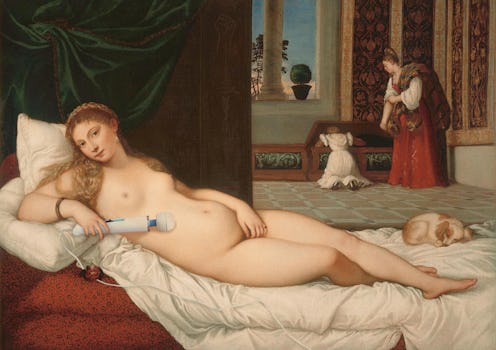
Have you ever visited an art museum and thought, "Wow, these paintings are really missing something?" Was your next thought that they could use some sort of erotic device to spice up the images — perhaps a Hitachi Magic Wand? Then your dream has come true in the Tumblr The Hitachi Magic Wand Throughout Art History, which is exactly what it sounds like. The anonymous man behind the site has strategically placed the decades-old "massager" in the scenes of several classic paintings, including Titian's Venus of Urbino and Maxfield Parrish's Daybreak. He doesn't actually think the paintings needed the addition, though; "It's impossible to improve on these paintings, so adding the vibrators is a bit of sacrilege," he told Bustle via email. But that's also what makes them so much fun.
When the original pieces were painted, female masturbation was more taboo than it is today — though at least one scholar has argued that, given the placement of her left hand, what Titian's Venus (above) was really up to was a little self-love. As such, the Photoshopped images make visible a common activity that has been erased from much of history and pop culture. Indeed, one 2009 study found that about 53 percent of women ages 18 to 60 have used vibrators and about 45 percent of men in the same age range have incorporated them into sexual activities. However, it's rare that we see any depictions of such usage today, let alone during the Renaissance (I know, they didn't even exist back then, but they should have! And female masturbation in general was rarely spoken of).
The Hitachi Magic Wand Throughout Art History makes up for lost time by incorporating the staple sex toy into old works of art. The site's creator explained his choice of device:
It's unassuming and utilitarian looking, but that makes it all the more iconic in my mind. I think that it deserves more attention. It's been quietly doing its thing without much praise from everyone's sock drawer for decades... I wanted to elevate the Magic Wand to another level, and combining it with these well-known masterpieces hopefully does that.
This combination mixes the high-brow with the low-brow, challenging the cultural assumption that erotic paintings of nude women belong in the hallowed halls of art galleries while a smartly and effectively designed device like the Hitachi Magic Wand belongs hidden in our sock drawers. Perhaps we have the patriarchy to blame for this notion of high and low culture: After all, many well-known paintings depict women as objects of visual pleasure, while vibrators are for women's pleasure (and, according to that study, also men's). And we're less comfortable with the latter.
If the Hitachi Magic Wand were a few centuries older and artists were open about their own and others' enjoyment of its powers, here are some paintings that may have existed. Head on over to The Hitatchi Magic Wand Throughout Art History for more.
1. Magic Wand Break (based on Daybreak by Maxfield Parrish)
2. Sweet Hitachi Summer (based on Sweet Summer by John Waterhouse)
3. The Creation of the Magic Wand (based on The Creation of Adam by Michelangelo)
4. Madonna Adoring the Hitachi (based on Adoration of the Child by Correggio)
5. Oath of the Hitachi (based on Oath of the Horatii by Jacques-Louis-David)
Now, that's a peace offering.
Head over to the Hitachi Magic Wand Throughout Art History Tumblr for more sacrilegious renderings of the paintings your art history professor taught you about.
Images: Courtesy of The Hitachi Magic Wand Throughout Art History